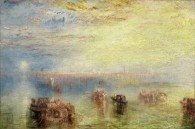Turner & Italy
dal 26/3/2009 al 6/6/2009
Segnalato da
Scottish National Gallery of Modern Art
26/3/2009
Turner & Italy
Scottish National Gallery of Modern Art, Edinburgh
The love affair between the artist J.M.W. Turner (1775-1851) and Italy

This major exhibition celebrates the love affair between the artist J.M.W. Turner (1775-1851) and Italy. It sets out to explore this complex and enduring relationship, and demonstrates how Turner became enchanted by the county’s climate, landscapes and architecture. Drawing inspiration from them he created some of the greatest images of Romantic art.
This is the only UK showing of this blockbuster exhibition, which includes outstanding loans from collections in America, Australia and Europe. Oil paintings, watercolours, sketchbooks and books from Turner’s own library will provide an unprecedented survey of Turner’s passion for Italy.
Turner’s fascination with Italian culture developed initially when, as a young man in London, he studied oil paintings, watercolours, sculptures, prints and books which gave a taste of the sites and treasures of Italy. He visited important private art collections and attended exhibitions and auctions, discovering the work of artists such as Titian, Veronese, Claude, Poussin and Piranesi.
The study of Italy and its art was promoted by the teaching and exhibiting institution Turner was most closely allied to - The Royal Academy of Arts. The Academy placed an overwhelming emphasis on the experience of Classical and Renaissance Italy as the source of artistic wisdom.
Turner was admitted to the Royal Academy Schools in 1789, and made drawings after its collection of plaster casts of classical sculpture. In 1802 he was elected a full Royal Academician. He was still only 27.
In 1819 Turner made his first visit to Rome, and the sheer drama of its setting, fired his imagination. He made numerous drawings in the Vatican, the Forum, and all over the seven hills of the city. Just over two months after his return from Italy he exhibited at the Royal Academy his magnificent panorama Rome from the Vatican.
Turner returned to Rome in 1828, living there for three months, enjoying the social life the city had to offer, and finding a studio in which to paint. The pictures he produced during his stay differed widely in terms of scale and subject matter, suggesting he was trying to demonstrate to his Roman audience the breadth of his accomplishments. They included an ambitious painting exploring the myth of Medea and his spectacular Palestrina – Composition, a view of the hill town east of Rome.
During the 1830s Turner made two further visits to Italy – in 1833 to Venice, and in 1836 to Turin. The second journey was undertaken with the only patron of Turner’s to actually travel with him to Italy - the Scottish landowner and collector Hugh Andrew Johnstone Munro of Novar (1797-1864).
Turner has come to be seen as one of the great interpreters of Venice. Its shifting, insubstantial qualities – the result of light dancing on water and architecture – was perhaps the perfect subject for him to address with his box of watercolours. He also proved, however, to be able to translate these effects into brilliant oil paintings.
He made his first visit in 1819, staying for about eight days, and worked on a number of pencil studies and watercolours. Turner travelled to the city again in the late summer of 1833, remaining for ten days and dashing off about twenty pencil sketches a day.
The final and most productive Venetian visit was made in 1840. He was sixty-five, and explored by foot and in gondolas, depicting the city by day and night, enjoying terrific electric storms and sultry calms. Turner depicted the famous sites – views of the Doge’s Palace and San Marco, and the Grand Canal thronged with craft – but arguably some of his greatest works from this period of intense creativity are more unconventional, informal images.
In 1843 Turner undertook a late summer tour of Switzerland, which involved travelling over the border to visit the north Italian lakes. His journey was curtailed due to illness. Turner’s health deteriorated further in 1845, but he continued working with astounding vigour and invention right up until his death in 1851.
It was with his pictures of these years that Turner above all pushed back conventional boundaries, sometimes working in a remarkably physical manner, using palette knives, rags and his hands, as well as a brush, to manipulate thickly textured (‘impastoed’) paint, and on other occasions exploring astoundingly bold combinations of colour.
Over one hundred and fifty years later his works of this period have lost none of their power to startle and intrigue.
Image: Approach to Venice, 1844, by JMW Turner - National Gallery of Art, Washington
Scottish National Gallery of Modern Art
75 Belford Road, EH4 3DR - Edinburgh



